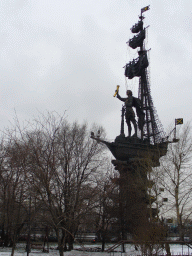
Our final two days in Russia were spent exploring Moscow's many sights. Highlights included a late night wander across Red Square, a visit to Gorky Park and a photo session in the snow with neglected statues from the communist era. This last sight seemed to encapsulate much of what Moscow has become. The city's art, displayed in every conceivable corner, often reflected the its enduring history.

Red Square was magnificent. St Basil's cathedral at the southern end was everything I'd ever imagined it would be. Even Lenin's tomb seemed appropriately scaled and modeled for its location by the Kremlin wall. During our first visit, a evening event, GUM department store was festooned with lights, while every cobblestone glistened with melting snow. Sadly the overall effect of the Square's environs were somewhat spoiled by a large, gaudy temporary ice skating rink outside GUM.

Gorky Park was a bitter disappointment. I'd imagined it to be a Soviet version of Central Park, but instead was greeted with shabby fences, semi-derelict side shows and abandoned buildings. It somehow seemed appropriate that one of three surviving Buran space shuttles should be on display in such shabby reminder of the soulless Soviet era.

Opposite Gorky Park is the far more aesthetic Sculpture Park. Here, set amongst trees and rose gardens, were the fallen idols of the Soviet era. Sitting in the snow were statues of Lenin, Stalin and other Soviet heroes. A particularly poignant area was that dedicated to the millions purged under Stalin's regime. Behind a defaced statue of Stalin sits a curving cage of broken heads, symbolising the lives lost.

Opposite the park, across the Moscow River, sits one of the Soviet era's most appalling art works. Here a 94.5 metre black statue of Peter the Great stands watch over a fork in the river. This makes it taller than the Statue of Liberty (excluding her pedestal). The statue is gaudy, ill-proportioned and towers over the surrounding neighbourhood. Designed by Zurab Tseretelli, the statue originally depicted Christopher Columbus and was offered to no less than five North American cities. All rejected it on the grounds of cost, size or aesthetics. In the end, the head of Columbus was changed to that of Peter the Great and the statue was presented to the city of Moscow.

By contrast, Moscow Metro stations are astonishing works of art. Each station is clad in marble, decorated with statues, mosaics, chandeliers and baroque trimmings. In the photo above are statues celebrating heroes of the revolution at Ploshchad Revolutisk station near Red Square. Unfortunately, the tasteful surroundings seem lost on local commuters who elbow their way into over-stuffed rail carriages, pushing aside young and old to secure a ride. I've seen more forgiving rugby scrums.

Our final cultural experience in Moscow was the circus. Without a doubt Russia does a circus like none other.




No comments:
Post a Comment